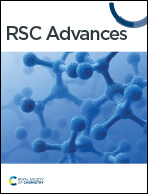Detection of sulfur mustard simulant by trisaryl phosphoric triamide-based resin using a quartz crystal microbalance sensor†
Abstract
Chemical warfare agents (CWAs) pose a persistent threat to human safety, and bis(2-chloroethyl) sulfide, or sulfur mustard (SM) is one of the most dangerous substances and is able to cause serious harm. Detecting SM gas is vital, but current methods have high-temperature requirements and limited selectivity, mainly because of the lack of CWA receptor development, and this makes them challenging to use. To address this issue, we present a trisaryl phosphoric triamide-based resin receptor that preferentially interacts with a SM simulant 2-chloroethyl ethyl sulfide (2-CEES) through dipole interactions. The receptor was synthesized through a facile process using an amine and a triethyl phosphate and the properties of its coating were enhanced using epoxy chemistry. The receptor's superior triamide structure was evaluated using a quartz crystal microbalance and reactivity was confirmed by observing the variations in reactivity according to the number of phosphoramides. The receptor showed better reactivity to 2-CEES vapor than to the known poly(epichlorohydrin) and showed selectivity to other volatile organic compounds. Moreover, its durability was evident even 30 days post-coating. The applicability of this receptor extends to array sensors, sound acoustic wave sensors, and chemo-resistive and chemo-capacitive sensors, and it promises advances in chemical warfare agent detection.



 Please wait while we load your content...
Please wait while we load your content...